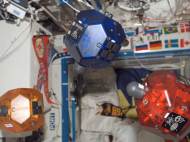NASA uses Smart SPHERES to test telerobotics in space
 With support from the Department of Defense and NASA, MIT undergraduates built five volleyball-sized free-flying satellites, and three of those have been on the International Space Station since 2006 to test a set of well-defined instructions for spacecraft performing autonomous rendezvous and docking maneuvers. Recently, the satellite got an upgrade that enables its remote operation via a smartphone controller.
With support from the Department of Defense and NASA, MIT undergraduates built five volleyball-sized free-flying satellites, and three of those have been on the International Space Station since 2006 to test a set of well-defined instructions for spacecraft performing autonomous rendezvous and docking maneuvers. Recently, the satellite got an upgrade that enables its remote operation via a smartphone controller.
Named Synchronized Position Hold, Engage, Reorient, Experimental Satellites (SPHERES), the satellite has its own onboard power, propulsion, computing and navigational software. Luckily, the team built an “expansion port” into each satellite in order to enable future integration of needed modules
After it got certified by NASA for use on the space station, Samsung Nexus S became the first smartphone addition that transformed the SPHERES from satellite into a free-flying robot they dubbed Smart SPHERES. The smartphone includes a four-inch touchscreen display, a 1-GHz processor, digital cameras, gyroscopes, accelerometers, proximity and light sensors, Bluetooth and Wi-Fi networking, as well as 16 gigabytes of internal memory.
Since it already has a compact, low-power, low-cost embedded computer and built-in cameras and sensors, the smartphone needed only minor modifications. Modifications include removal of the GSM cellular communications chip to avoid interference with station electronics, and replacement of the standard lithium-ion battery with AA alkaline batteries.
“By connecting a smartphone, we can immediately make SPHERES more intelligent. With the smartphone, the SPHERES will have a built-in camera to take pictures and video, sensors to help conduct inspections, a powerful computing unit to make calculations, and a Wi-Fi connection that we will use to transfer data in real-time to the space station and mission control”, said DW Wheeler, lead engineer in the Intelligent Robotics Group at NASA’s Ames Research Center in Moffett Field, California.
As with the Robonaut 2, all tests thus far have been performed in the safety of the space station’s interior. Smart SPHERES will conduct interior station surveys and inspections, capturing mobile camera images and video, and NASA plans to simulate external free-flight excursions and in time will test whether the robots can handle more challenging tasks.
“The tests that we are conducting with Smart SPHERES will help NASA make better use of robots as assistants to and versatile support for human explorers – in Earth orbit or on long missions to other worlds and new destinations”, said Terry Fong, project manager of the Human Exploration Telerobotics project and Director of the Intelligent Robotics Group at Ames. “That way, astronauts can spend more time performing science experiments and other work, instead of routine maintenance. In the long run, free-flying robots like SPHERES could also be used to inspect the exterior of the space station or future deep-space vehicles.”









Leave your response!